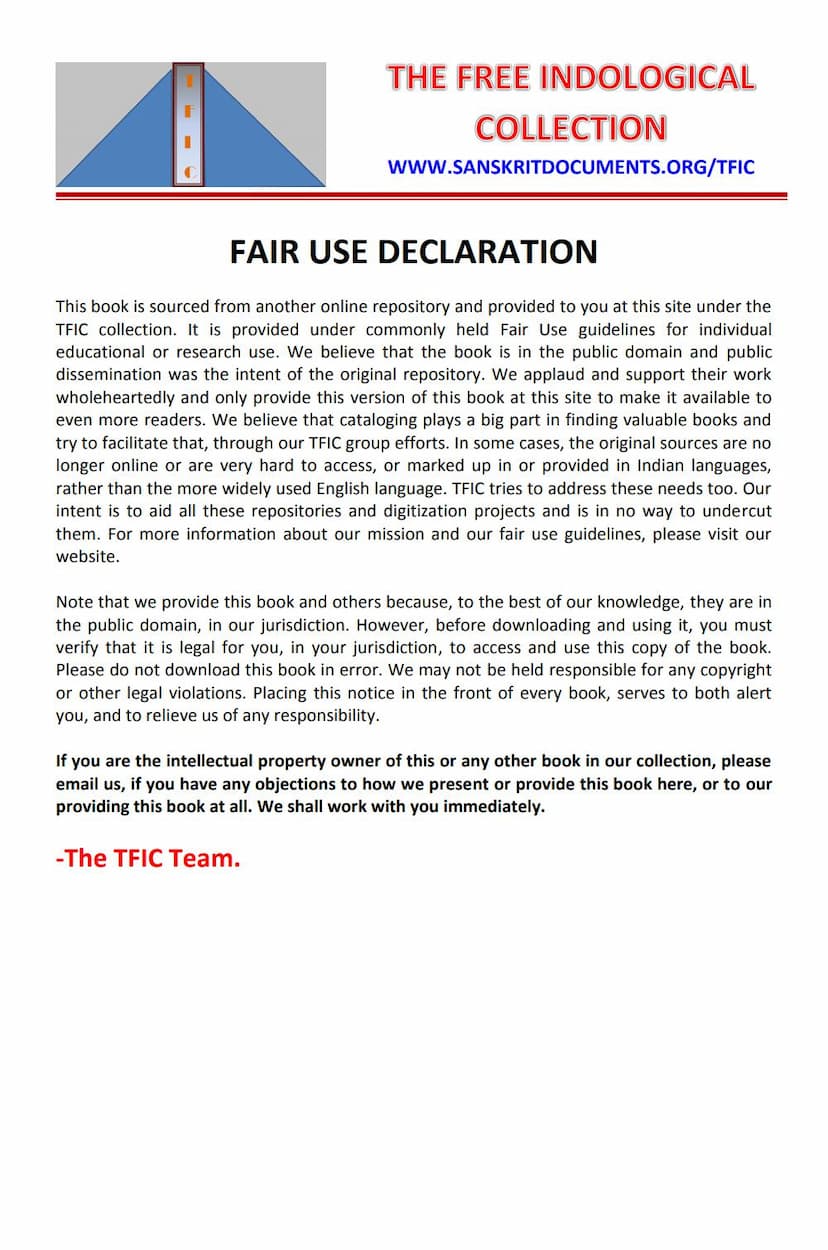Pahuda Doha
Added to library: September 2, 2025

Summary
Here's a comprehensive summary of the Jain text "Pahuda Doha" by Hiralal Jain, based on the provided pages:
Book Title: Pahuda Doha (पाहुड दोहा) Author: Ramasinha Muni (रामसिंह मुनि) Editor: Hiralal Jain (हीरालाल जैन) Publisher: Karanja Jaina Publication Society (कारंजा जैन पब्लिकेशन सोसायटी) Language: Apabhramsa Subject: Jain Mysticism
Overview: "Pahuda Doha" is a significant work on Jain mysticism composed in the Apabhramsa language by Ramasinha Muni. The book, critically edited with extensive scholarly apparatus by Hiralal Jain, provides insights into Jain spiritual practices and philosophical concepts. The text utilizes the "doha" verse form and is considered a valuable contribution to the study of Jain literature and mysticism.
Key Aspects and Content Summary:
-
Language and Style:
- The work is written in Apabhramsa, a late Middle Indo-Aryan language that served as a precursor to modern North Indian languages. The editor, Hiralal Jain, notes its similarity to the Apabhramsa described by Hemacandra in his Prakrit grammar.
- The language is characterized by its simplicity, clarity, and poetic flow, making it accessible for conveying profound spiritual ideas.
- The editor emphasizes that while grammarians call this language "Apabhramsa," poets often referred to it as "Deshi Bhasha" (local or vernacular language).
-
Subject Matter: Jain Mysticism:
- The core theme of "Pahuda Doha" is Jain mysticism. It focuses on the inner spiritual journey, the nature of the soul, the path to liberation (moksha), and the illusory nature of the material world.
- The text delves into themes such as renunciation (tyaga), self-realization (atmanubhava), conquest of senses (indriya vijaya), and the importance of meditation (dhyana).
- It criticizes external rituals and superficial practices, emphasizing the need for inner purity and spiritual transformation.
-
Mystical and Symbolic Language:
- The work employs symbolic and esoteric language common in yogic and tantric traditions. Terms like Ravi (Sun), Shashi (Moon), Vama, Dakshina, Shiva, and Shakti are used metaphorically.
- The body is often described as a "temple" (dehalaya) where the divine resides, and the soul is referred to as "Shiva."
- The editor notes that these symbolic terms resonate with similar expressions found in Buddhist Caryapadas and Dohakoshas, as well as the works of Jain saints like Kundakunda and Yogindra.
-
Author and Authorship:
- The author is identified as Ramasinha Muni, as mentioned in verse 211 and the colophon of one of the manuscripts.
- However, another manuscript attributes the work to Yogindra Deva. The editor discusses this discrepancy, acknowledging the strong textual similarities between "Pahuda Doha" and Yogindra Deva's known works like "Paramatm-prakasha" and "Yogasara."
- While acknowledging the possibility of Yogindra Deva being the author or that verses were borrowed, the editor tentatively attributes the work to Ramasinha Muni due to the explicit mention within the text itself, pending further evidence.
-
Relationship with Other Texts:
- "Pahuda Doha" shares significant overlaps in both content and language with other Jain spiritual texts, notably:
- Kundakunda's works: Particularly strong thematic and linguistic parallels.
- Yogindra Deva's "Paramatm-prakasha" and "Yogasara": A substantial portion of "Pahuda Doha" is found almost verbatim in these works, leading to scholarly debate about the original author.
- Devasenacharya's "Savayadhamma-doha": Shared verses and stylistic similarities, although "Savayadhamma-doha" is aimed at lay householders while "Pahuda Doha" is for yogis.
- Shrutasagar's commentary on "Savayadhamma-doha": Citations from "Pahuda Doha" appear in this commentary.
- Hemacandra's Apabhramsa Grammar: Several verses from "Pahuda Doha" are quoted as examples in Hemacandra's grammar, providing crucial evidence for its antiquity and linguistic importance.
- "Pahuda Doha" shares significant overlaps in both content and language with other Jain spiritual texts, notably:
-
Dating the Work:
- Based on its inclusion of verses quoted by Hemacandra (circa 1100 AD) and its own inclusion of verses from "Savayadhamma-doha" (circa 933 AD), the work is estimated to have been composed around 1000 AD.
-
Editor's Contribution (Hiralal Jain):
- Hiralal Jain's contribution is substantial, involving critical editing from two manuscripts.
- He provides a detailed Introduction (Bhumika) covering:
- Manuscript sources: Describing the two manuscripts used for the edition.
- Name of the text: Explaining the meaning of "Pahuda" and "Doha."
- Subject matter and style: Discussing the mystical themes and poetic style.
- Mysticism in "Pahuda Doha": Analyzing the symbolic and esoteric elements.
- Relationship with other works: Detailed comparisons with prominent Jain texts.
- Author: Discussing the authorship question.
- Date of composition: Providing historical and linguistic evidence for dating.
- Deshi Bhasha and Apabhramsa: A scholarly discussion on the terminology and classification of the language.
- The edition includes a literal translation, glossary (Shabdakosh), critical notes (Tippani), and an index. The editor aimed for a translation that closely followed the Apabhramsa structure, even at times sacrificing idiomatic Hindi.
-
Key Themes and Teachings:
- The transient nature of worldly pleasures: Emphasizing that sensory pleasures are temporary and lead to suffering.
- The soul as eternal and distinct from the body: The soul (Atman) is the true essence, distinct from the physical body and its limitations.
- The importance of inner transformation: True spiritual attainment comes from controlling the mind and senses, not from external rituals or ascetic practices alone.
- The role of the Guru: The text acknowledges the guidance of a Guru in understanding the deeper spiritual truths.
- Critique of blind faith and rituals: The author cautions against attachment to external forms and rituals without inner realization.
- The concept of the true "Jogi" or realized being: One who has controlled the mind, senses, and overcome passions.
Significance: "Pahuda Doha" is a foundational text for understanding Jain mysticism and the development of Apabhramsa literature. The critical edition by Hiralal Jain makes this important work accessible to scholars and practitioners, shedding light on the spiritual philosophy and linguistic heritage of Jainism. The detailed analysis of its mystical elements and its connections to other classical Jain texts make it an invaluable resource.